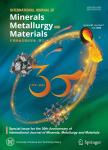Reduction behavior of hematite in the presence of coke
Reduction behavior of hematite in the presence of coke作者机构:College of Resources and Civil Engineering Northeastern University Shenyang 110819 China College of Mining Engineering North China University of Science and Technology Tangshan 063009 China CITIC Pacific Mining Management Pty Ltd. 45 St. Georges Terrace Perth WA6000 Australia
出 版 物:《International Journal of Minerals,Metallurgy and Materials》 (矿物冶金与材料学报(英文版))
年 卷 期:2016年第23卷第11期
页 面:1244-1251页
核心收录:
学科分类:0709[理学-地质学] 0819[工学-矿业工程] 0806[工学-冶金工程] 08[工学] 0708[理学-地球物理学] 0805[工学-材料科学与工程(可授工学、理学学位)] 080601[工学-冶金物理化学] 0703[理学-化学] 0802[工学-机械工程] 0801[工学-力学(可授工学、理学学位)] 0702[理学-物理学]
基 金:financially supported by the National Natural Science Foundation of China (No.51134002) the Fundamental Research Funds for the Central Universities of China (No.N140106001)
主 题:hematite ore reduction reduction kinetics coke
摘 要:The reduction kinetics of hematite in the presence of coke as a reductant was studied via isothermal and non-isothermal thermodynamic analyses. The isothermal reduction of hematite was conducted at a pre-determined temperature ranging from 1423 to 1573 K. The results indicated that a higher reduction temperature led to an increased reduction degree and an increased reduction rate. The non-isothermal reduction of hematite was carried out from room temperature to 1573 K at various heating rates from 5 to 15 K·min^(-1). A greater heating rate gave a greater reduction rate but decreased reduction degree. With an increase in temperature, both the reduction rate and the reduction degree increased at a smaller rate when the temperature was less than 1150 K, and they increased at a higher rate when the temperature was greater than 1150 K before completion of the reduction reaction. Both the isothermal and the non-isothermal reduction behaviors of hematite were described by the Avrami–Erofeev model. For the isothermal reduction, the apparent activation energy and pre-exponential factor were 171.25 kJ ·mol^(-1) and 1.80 × 10~5 min^(-1), respectively. In the case of non-isothermal reduction, however, the apparent activation energy and pre-exponential factor were correlated with the heating rate.



